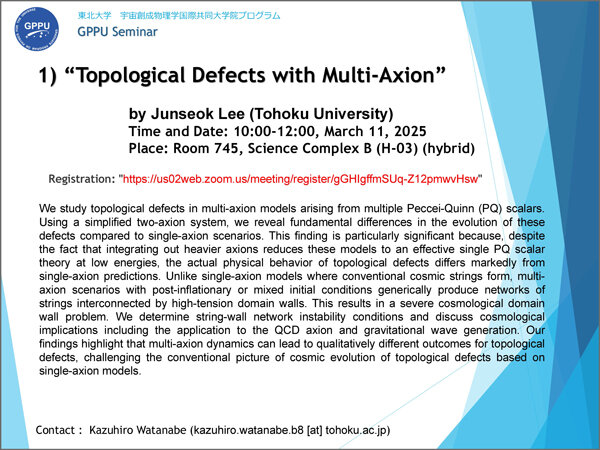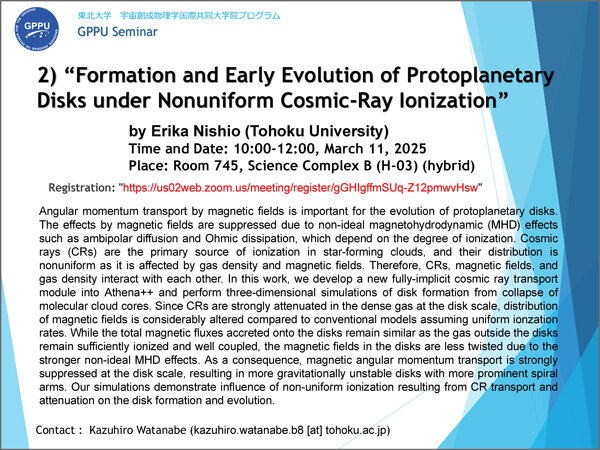NEWS
GP-PU Seminar
Time and Date
10:00-12:00, March 11, 2025
Title
1) Topological Defects with Multi-Axion
by Junseok Lee (Tohoku University)
We study topological defects in multi-axion models arising from multiple Peccei-Quinn (PQ) scalars. Using a simplified two-axion system, we reveal fundamental differences in the evolution of these defects compared to single-axion scenarios. This finding is particularly significant because, despite the fact that integrating out heavier axions reduces these models to an effective single PQ scalar theory at low energies, the actual physical behavior of topological defects differs markedly from single-axion predictions. Unlike single-axion models where conventional cosmic strings form, multi-axion scenarios with post-inflationary or mixed initial conditions generically produce networks of strings interconnected by high-tension domain walls. This results in a severe cosmological domain wall problem. We determine string-wall network instability conditions and discuss cosmological implications including the application to the QCD axion and gravitational wave generation. Our findings highlight that multi-axion dynamics can lead to qualitatively different outcomes for topological defects, challenging the conventional picture of cosmic evolution of topological defects based on single-axion models.
2) Formation and Early Evolution of Protoplanetary Disks under Nonuniform Cosmic-Ray Ionization
by Erika Nishio (Tohoku University)
Angular momentum transport by magnetic fields is important for the evolution of protoplanetary disks. The effects by magnetic fields are suppressed due to non-ideal magnetohydrodynamic (MHD) effects such as ambipolar diffusion and Ohmic dissipation, which depend on the degree of ionization. Cosmic rays (CRs) are the primary source of ionization in star-forming clouds, and their distribution is nonuniform as it is affected by gas density and magnetic fields. Therefore, CRs, magnetic fields, and gas density interact with each other. In this work, we develop a new fully-implicit cosmic ray transport module into Athena++ and perform three-dimensional simulations of disk formation from collapse of molecular cloud cores. Since CRs are strongly attenuated in the dense gas at the disk scale, distribution of magnetic fields is considerably altered compared to conventional models assuming uniform ionzation rates. While the total magnetic fluxes accreted onto the disks remain similar as the gas outside the disks remain sufficiently ionized and well coupled, the magnetic fields in the disks are less twisted due to the stronger non-ideal MHD effects. As a consequence, magnetic angular momentum transport is strongly suppressed at the disk scale, resulting in more gravitationally unstable disks with more prominent spiral arms. Our simulations demonstrate influence of non-uniform ionization resulting from CR transport and attenuation on the disk formation and evolution.
Place (hybrid)
Room 745, Science Complex B (MAP H-03)
Zoom registration for participants:
https://us02web.zoom.us/meeting/register/gGHIgffmSUq-Z12pmwvHsw
Point
GSP = 1
Contact
Kazuhiro Watanabe (Physics, GP-PU),
E-mail: kazuhiro.watanabe.b8*tohoku.ac.jp (Replace * with @)


Posted on:March 4, 2025




